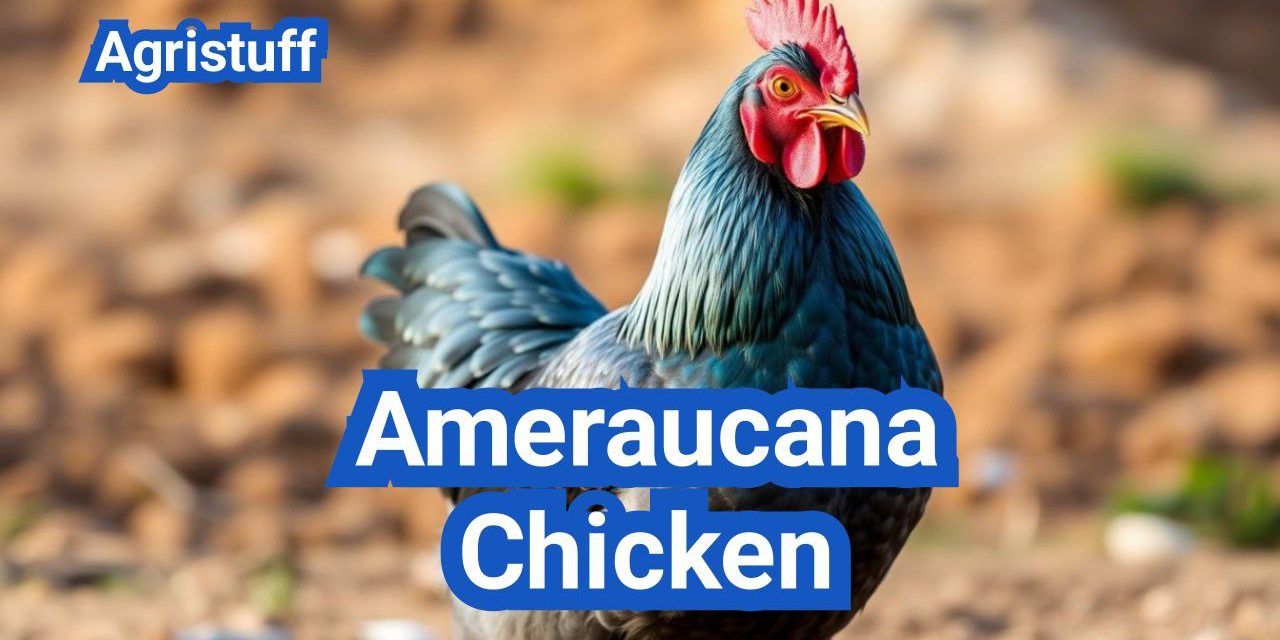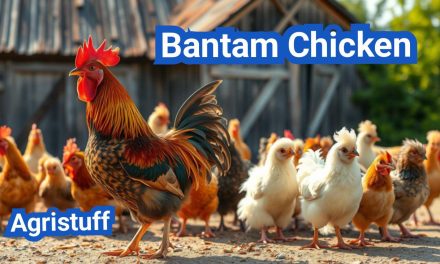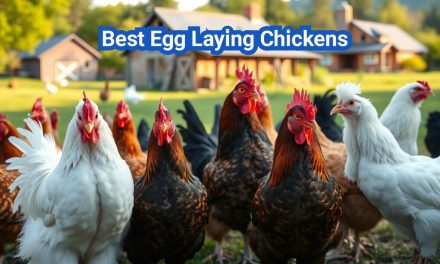The Ameraucana chicken breed is a purebred American favorite, renowned for its stunning blue eggs and friendly demeanor. Originating from Chile, the breed was developed in the United States and has since become a popular choice among backyard chicken keepers.
This breed is not only admired for its unique egg-laying abilities but also for its docile nature, making it an excellent choice for families. With its rich history and numerous benefits, the Ameraucana is a breed that stands out in the world of poultry.
Key Takeaways
- Ameraucana chickens are known for laying blue eggs.
- They have a friendly and docile temperament.
- The breed is a popular choice among backyard chicken keepers.
- Ameraucana chickens are purebred American chickens.
- They are admired for their unique characteristics and benefits.
The History and Origin of Ameraucana Chickens
Ameraucana chickens were bred in America to preserve the desirable trait of blue egg-laying while addressing health concerns associated with their Araucana ancestors. The development of this breed is a testament to the innovative spirit of American poultry breeders.
Development of the Breed in America
The Ameraucana breed was developed in the United States in the 1970s, primarily by breeding Araucana chickens with other domestic breeds. The goal was to retain the Araucana’s ability to lay blue eggs while eliminating the lethal gene that often resulted in the death of Araucana embryos. Through careful selection and breeding, the Ameraucana emerged as a distinct breed with improved viability and the same unique egg-laying characteristics as its Araucana predecessors.
The breeders’ efforts focused on creating a chicken that was not only a prolific layer of blue eggs but also robust and healthy. This involved selective breeding to enhance the desirable traits while minimizing the health risks associated with the Araucana breed.
Relationship to Araucana Chickens
The Ameraucana chicken is closely related to the Araucana breed, originating from South America. Araucanas are known for their ability to lay blue eggs, a trait that has been preserved in Ameraucanas. However, Araucanas often carry a lethal gene that can result in embryonic death, a problem that Ameraucana breeders sought to eliminate.
By understanding the history and development of Ameraucana chickens, we can appreciate the careful breeding practices that have made this breed a favorite among backyard chicken keepers and poultry enthusiasts.
| Characteristic | Araucana | Ameraucana |
|---|---|---|
| Origin | South America | United States |
| Egg Color | Blue | Blue |
| Lethal Gene Presence | Often Present | Minimized through Breeding |
The Ameraucana Chicken Breed Standards

The breed standards for Ameraucana chickens encompass a range of characteristics, from their distinctive red pea comb to their egg-laying prowess. These standards are crucial for maintaining the breed’s integrity and ensuring that Ameraucana chickens continue to thrive as America’s famous blue egg layers.
Official Recognition and Breed Characteristics
The Ameraucana chicken was officially recognized by the American Poultry Association in 1984. This recognition came with the establishment of specific breed characteristics that define the Ameraucana breed. Key characteristics include a red pea comb, muffs, and beards, which are distinctive features of this breed.
The breed standards also specify that Ameraucana chickens should have a well-rounded body, with a moderate size and a graceful appearance. Their legs and feet are clean and free of feathers, and they have a medium-sized beak.
| Breed Characteristic | Description |
|---|---|
| Comb | Red pea comb |
| Muffs and Beard | Presence of muffs and beards |
| Legs and Feet | Clean, free of feathers |
| Egg Color | Blue |
The Ameraucana Breeders Club
The Ameraucana Breeders Club plays a vital role in promoting and preserving the Ameraucana breed. The club works closely with breeders to ensure that the breed standards are maintained and that the breed continues to thrive.
Members of the Ameraucana Breeders Club are dedicated to the breed and work to educate others about the importance of adhering to breed standards. The club also provides resources and support for breeders, helping them to improve their breeding programs and to produce high-quality Ameraucana chickens.
Physical Characteristics of Ameraucana Chickens
The Ameraucana breed is recognized by its medium size and several distinctive physical attributes. Ameraucana chickens are known for their sturdy build and unique features, making them a popular choice among backyard poultry keepers.
Size and Weight Expectations
Ameraucana chickens are classified as medium-sized birds. Roosters typically weigh between 6.5 and 7.5 pounds, while hens usually weigh between 5.5 and 6.5 pounds. This size makes them substantial enough to be considered a robust breed without being too large for most backyard flocks.
| Gender | Weight Range (lbs) |
|---|---|
| Rooster | 6.5 – 7.5 |
| Hens | 5.5 – 6.5 |
Distinctive Pea Comb and Facial Features
One of the most distinctive features of Ameraucana chickens is their pea comb, which is a small, tightly packed comb that resembles a series of small peas clustered together. This feature is not only aesthetically pleasing but also practical in cold climates as it is less prone to frostbite compared to larger combs.
In addition to their pea comb, Ameraucana chickens are characterized by their muffs and beards. These facial features give them a unique appearance and add to their charm. The muffs are feathering on the sides of the face, and the beard is the feathering under the beak, creating a distinctive and attractive facial profile.
Body Type and Structure
Ameraucana chickens have a well-rounded, sturdy body that is slightly longer than it is tall. They possess a broad, rounded breast and a back that is carried at a slight angle. Their wings are of moderate size and are carried close to the body, contributing to their compact appearance.
Their legs are strong and well-feathered, with four toes on each foot. The overall structure of the Ameraucana chicken is designed for both beauty and functionality, making them a versatile breed for egg production and as a visually appealing addition to any flock.
Ameraucana Chicken Colors and Varieties

Ameraucana chickens come in a multitude of colors, including black, blue, and wheaten, each with its unique charm. This diversity in color makes them a visually appealing addition to any backyard flock.
Standard Recognized Color Varieties
The Ameraucana breed is recognized in several colors by poultry associations. The standard recognized colors include:
- Black
- Blue
- Wheaten
- Silver
- Buff
These colors are a result of careful breeding and selection, ensuring that each bird meets the breed standards.
Bantam Ameraucana Varieties
In addition to the standard Ameraucana, there are also bantam varieties. Bantam Ameraucanas are smaller versions of the standard breed, retaining the same color varieties and characteristics. They are ideal for smaller backyard flocks or for those who prefer the miniature version of the breed.
Identifying True Ameraucana Colors
Identifying true Ameraucana colors involves looking at the specific characteristics of the breed. The colors should be rich and vibrant, with distinct patterns where applicable. The table below summarizes the key color characteristics and their distinguishing features.
| Color Variety | Description | Distinguishing Features |
|---|---|---|
| Black | Uniform black plumage | Glossy sheen |
| Blue | Uniform blue plumage | Varies from light sky blue to deep slate blue |
| Wheaten | Warm, golden wheaten color | Rich, even tone |
By understanding these color varieties and characteristics, breeders and backyard chicken keepers can better identify and appreciate the beauty of Ameraucana chickens.
The Famous Blue Eggs of Ameraucana Chickens
Ameraucana chickens are renowned for their unique blue eggs, a trait that has captivated poultry enthusiasts worldwide. This distinctive characteristic is not just aesthetically pleasing but also a result of fascinating genetics.
Understanding Blue Egg Genetics
The blue egg color in Ameraucana chickens is due to a genetic trait known as oocyanin, which is deposited on the eggshell as it forms. Unlike other pigments that may affect eggshell color, oocyanin penetrates the shell, resulting in a blue color that is consistent throughout.
Genetic Basis: The genetics behind the blue egg trait is rooted in a retrovirus that inserts itself into the chicken’s genome, enabling the production of oocyanin. This genetic factor is dominant, meaning that a chicken only needs to inherit one copy of the gene to lay blue eggs.
Egg Color Variations and Intensity
While Ameraucana chickens are known for laying blue eggs, there can be variations in the intensity of the blue color. Some eggs may appear more pale or sky blue, while others may have a deeper, richer blue hue.
The intensity of the blue color can be influenced by several factors, including genetics, diet, and the health of the hen. For instance, a diet rich in certain nutrients can enhance the color of the eggs.
Egg Production Rates and Expectations
Ameraucana chickens are prolific layers, producing around 200-250 eggs per year. The egg production rate can be influenced by factors such as nutrition, lighting, and overall health of the flock.
| Year | Average Eggs per Year | Factors Influencing Production |
|---|---|---|
| 1 | 200-220 | Nutrition, Lighting |
| 2 | 220-250 | Health, Management Practices |
| 3+ | 200-230 | Age, Environmental Conditions |
By understanding the genetics and factors that influence egg production and color, backyard chicken keepers can better manage their Ameraucana flocks to maximize the yield of these beautiful blue eggs.
Ameraucana vs. Easter Egger: How to Tell the Difference

Ameraucana and Easter Egger chickens are often confused with one another, but they have distinct differences. The primary distinction lies in their breeding and the consistency of their egg-laying traits.
Breed Standards vs. Mixed Heritage
Ameraucana chickens are a purebred breed recognized by the American Poultry Association (APA). They have a specific breed standard that includes characteristics such as size, feather color, and comb type. In contrast, Easter Eggers are not a recognized breed but rather a category of chickens that are the result of crossing an Ameraucana or Araucana with another breed. This mixed heritage means that Easter Eggers can vary significantly in appearance and egg-laying ability.
The breed standard for Ameraucanas is strict, ensuring that birds bred to this standard will consistently produce blue eggs. Easter Eggers, due to their mixed ancestry, may or may not lay blue eggs, and the intensity of the blue color can vary.
Egg Color Expectations and Variations
One of the most significant differences between Ameraucanas and Easter Eggers is the consistency of egg color. Ameraucanas are known for laying blue eggs, and this trait is consistent across the breed. Easter Eggers, on the other hand, can lay a variety of egg colors, including blue, green, pink, or even white, depending on their genetic makeup.
While both can produce colorful eggs, the predictability of egg color is much higher in Ameraucanas due to their purebred status. For those looking for a consistent blue egg layer, Ameraucanas are the better choice. For those who enjoy the surprise of different egg colors, Easter Eggers can be a fun addition to a flock.
Ameraucana Chicken Temperament and Behavior

Ameraucana chickens are renowned for their friendly and docile nature, making them an excellent addition to any backyard flock. Their calm demeanor and friendly disposition have made them a favorite among backyard chicken keepers.
Personality Traits of Roosters and Hens
Ameraucana roosters are known for their confident yet gentle personalities. They are generally not aggressive and can get along well with other roosters if introduced properly. Hens, on the other hand, are docile and friendly, making them a great choice for families with children.
Some key personality traits of Ameraucana chickens include:
- Friendly and docile nature
- Curious and active
- Generally good with children and other pets
- Can be quite vocal, with a range of sounds to communicate
Flock Dynamics and Compatibility with Other Breeds
Ameraucana chickens are generally easy-going and can integrate well into existing flocks. However, as with any new addition, it’s essential to introduce them slowly and under supervision to ensure a smooth transition.
Some benefits of keeping Ameraucana chickens in a mixed flock include:
- Their calm nature can help to reduce stress among other birds
- They are active foragers, which can help with pest control
- Their friendly disposition makes them a great addition to a diverse flock
By understanding the temperament and behavior of Ameraucana chickens, you can better appreciate their unique characteristics and make informed decisions about adding them to your flock.
How to Raise Ameraucana Chicks Successfully

The journey of raising Ameraucana chicks begins with a well-planned brooding setup. A successful start is crucial for the health and development of these unique birds.
Brooding Setup and Temperature Requirements
A proper brooding setup is essential for raising Ameraucana chicks. This includes a clean, dry brooder with adequate ventilation. The brooder should be equipped with a heat source, such as a heat lamp or a heating plate, to maintain the required temperature. For the first few weeks, the temperature should be around 90-95°F (32-35°C), gradually decreasing as the chicks grow.
Temperature control is critical in the early stages. Use a thermometer to monitor the temperature, and adjust the heat source as necessary. Ensure that the brooder is draft-free and provides enough space for the chicks to move around comfortably.
Chick Identification and Color Development
Identifying Ameraucana chicks and understanding their color development is fascinating. Initially, the chicks may not display the characteristic features of the breed, but as they mature, their true colors and traits become apparent. Observing the chicks’ growth and noting any changes in their appearance can be a fun and educational experience.
Ameraucana chicks start with a basic coloration that evolves as they grow. The final feather color and pattern may take several months to fully develop. Keeping track of their development helps in identifying any potential issues early on.
Common Challenges in Raising Ameraucana Chicks
Raising Ameraucana chicks comes with its challenges. One of the common issues is maintaining the right temperature and humidity levels in the brooder. Health issues can arise if the chicks are not kept in a clean and safe environment.
- Monitor the chicks’ health daily, looking for signs of illness or stress.
- Ensure the brooder is clean and dry to prevent health issues.
- Provide adequate space to prevent overcrowding, which can lead to stress and other problems.
By understanding these challenges and taking proactive steps, you can successfully raise healthy Ameraucana chicks.
Creating the Ideal Housing for Ameraucana Chickens

To keep Ameraucana chickens happy and healthy, their housing needs careful consideration. A well-designed coop and adequate run space are crucial for their overall well-being and productivity.
Coop Design Considerations
The coop is the heart of your Ameraucana chicken housing, providing shelter and protection from predators. When designing the coop, consider the size, ventilation, and ease of cleaning. A good rule of thumb is to provide at least 3-4 square feet per chicken inside the coop. Proper ventilation is essential to prevent moisture buildup, which can lead to respiratory issues.
Adequate lighting is also important, as it affects the chickens’ laying cycle. While Ameraucana chickens are known for their blue eggs, their production can be influenced by the amount of daylight they receive. Ensure the coop is well-lit, either naturally or through supplemental lighting, especially during the shorter days of winter.
Run Space and Free-Range Options
The run or enclosed area where chickens can exercise is just as important as the coop. Ameraucana chickens are active and need space to roam. The run should provide at least 8-10 square feet per chicken. Fencing is a critical component of the run, as it needs to protect the chickens from predators. The height and material of the fencing will depend on the types of predators in your area.
For those who have the space and resources, free-ranging can be a great option. Free-ranging allows chickens to forage for insects, seeds, and plants, which can enhance their diet and overall health. However, it’s essential to supervise free-ranging chickens to protect them from predators and prevent them from damaging neighboring gardens or properties.
In conclusion, creating the ideal housing for Ameraucana chickens involves careful planning of both the coop and the run. By considering the chickens’ needs for space, safety, and comfort, you can ensure they thrive and continue to produce their beautiful blue eggs.
Feeding Your Ameraucana Chickens for Optimal Health and Egg Production

Ameraucana chickens, known for their blue eggs, have specific dietary requirements that, when met, ensure their overall health and productivity. A well-balanced diet is crucial for maintaining the health of your flock and optimizing egg production.
Best Feed Formulations for Blue Egg Layers
The best feed for Ameraucana chickens should be rich in proteins, vitamins, and minerals. A layer feed with 16-18% protein content is recommended for laying hens.
- High-quality protein sources
- Adequate calcium for eggshell production
- Vitamin D3 for calcium absorption
Supplements and Treats
While a balanced layer feed should be the mainstay of their diet, supplements and treats can enhance the nutritional profile. Calcium supplements, for instance, are crucial for strong eggshell production.
Examples of healthy treats include:
- Oats
- Fresh vegetables
- Fruits
Seasonal Feeding Adjustments
Adjusting the feed according to the season can help maintain the health and productivity of your Ameraucana chickens. For example, during colder months, increasing the energy content of their feed can help keep them warm.
| Nutrient | Recommended Amount | Purpose |
|---|---|---|
| Protein | 16-18% | Supports egg production and overall health |
| Calcium | 3.5-4% | Essential for strong eggshells |
| Vitamin D3 | 1000-2000 IU/kg | Critical for calcium absorption and bone health |
By understanding and implementing the right feeding strategies, you can ensure your Ameraucana chickens remain healthy and productive, providing you with a steady supply of their signature blue eggs.
Health Care Guide for Ameraucana Chickens
To keep Ameraucana chickens healthy, it’s crucial to address common health issues proactively. Ameraucana chickens are generally a hardy breed, but like all poultry, they can be susceptible to certain health concerns. Understanding these issues is key to maintaining a healthy flock.
Common Health Concerns
Ameraucana chickens can be prone to specific health issues due to their genetic makeup and physical characteristics. One of the primary concerns is their susceptibility to certain diseases. Regular vaccinations and check-ups with a veterinarian can help mitigate these risks. Additionally, maintaining a clean coop and run is essential for preventing the spread of disease.
Key health concerns include:
- Respiratory issues due to their pea comb
- Susceptibility to certain parasites
- Genetic disorders if not bred carefully
Preventing Pea Comb Frostbite in Cold Climates
The pea comb of Ameraucana chickens, while a distinctive feature, can also be a liability in cold climates. Frostbite is a risk, particularly in harsh winters. To prevent this, owners can take several precautions:
Protective measures include:
- Providing a well-insulated coop
- Applying petroleum jelly to the comb during extreme cold snaps
- Ensuring good ventilation to prevent moisture buildup
Implementing Biosecurity for Small Flocks
Biosecurity is crucial for all backyard chicken keepers, including those with Ameraucana chickens. Implementing biosecurity measures helps protect the flock from diseases. This includes:
Biosecurity practices:
- Limiting visitor access to the coop and run
- Using disinfectants regularly on equipment and surfaces
- Monitoring the flock’s health daily
As one expert notes, “Biosecurity is not just about keeping your chickens safe; it’s about creating a healthy environment for both your flock and your family.” Effective biosecurity is a cornerstone of responsible chicken keeping.
How to Maximize Blue Egg Production from Your Ameraucana Flock

Ameraucana chickens are renowned for their blue eggs, and with the right techniques, you can maximize their egg-laying potential. To achieve this, it’s crucial to understand the factors that influence their productivity.
Lighting Strategies for Winter Laying
One of the key factors affecting egg production is lighting. During the winter months, the shorter days can lead to a decrease in laying. To counteract this, consider implementing supplemental lighting in your coop. Providing 14 hours of light per day can significantly boost egg production. It’s essential to use a timer to ensure consistency, as fluctuations can stress the hens.
“Supplemental lighting can make a significant difference in egg production during the winter,” says an experienced poultry keeper. “It’s a simple yet effective way to keep your Ameraucana hens laying consistently.”
Proper Egg Collection and Storage Techniques
Regular egg collection is vital not only for encouraging the hens to continue laying but also for maintaining the quality of the eggs. Collect eggs at least once a day, and store them in a cool, dry place. Pointed end down is the recommended storage orientation to keep the yolks centered.
- Collect eggs daily to encourage continuous laying.
- Store eggs in a cool, dry place to maintain quality.
- Keep the pointed end down to center the yolk.
Managing Seasonal Production Fluctuations
Seasonal changes can affect egg production. Besides lighting, factors such as temperature and nutrition play a role. Ensure your hens are comfortable and receiving a balanced diet. Adjusting their feed according to the season can help maintain production levels. For instance, adding more calories during colder months can help keep them warm and productive.
By understanding and managing these factors, you can maximize the blue egg production from your Ameraucana flock, enjoying a steady supply of these unique eggs throughout the year.
Breeding Ameraucana Chickens: A Guide for Beginners

The process of breeding Ameraucana chickens requires careful planning and attention to breed standards. This breed is renowned for its ability to lay blue eggs, a trait that has made it a favorite among poultry enthusiasts.
Selecting Quality Breeding Stock
Selecting the right breeding stock is crucial for a successful breeding program. When choosing Ameraucana chickens for breeding, look for birds that closely match the breed standards. This includes evaluating their physical characteristics, such as the pea comb, facial features, and egg color.
- Evaluate the health and vigor of the birds.
- Check for conformity to breed standards.
- Consider the egg-laying ability of hens.
Maintaining Breed Standards in Your Flock
Maintaining the breed standards is essential for preserving the unique characteristics of Ameraucana chickens. Regularly assess your flock to ensure they continue to meet these standards. This involves monitoring their physical traits, egg production, and overall health.
To keep your breeding program on track, it’s also important to keep detailed records of your birds’ lineage, health, and production. This will help you make informed decisions when selecting breeding stock.
Is the Ameraucana Chicken Right for Your Flock?
The Ameraucana chicken is a popular choice among backyard flock owners due to its friendly nature and unique blue eggs. To determine if this breed is right for your flock, consider its characteristics, benefits, and challenges. Ameraucana chickens are known for their cold hardiness and relatively low maintenance care, making them a great choice for many backyard chicken keepers.
When deciding to add Ameraucana chickens to your backyard flock, consider factors such as space, feed, and health care. With proper management, Ameraucana chickens can be a wonderful addition to your chicken breed collection, providing a steady supply of blue eggs and friendly companionship.
Ultimately, the Ameraucana chicken breed can thrive in a well-managed backyard flock, offering a unique and rewarding experience for chicken enthusiasts. By understanding the needs and characteristics of this breed, you can make an informed decision about whether the Ameraucana chicken is right for your flock.
FAQ
What is the average lifespan of an Ameraucana chicken?
Ameraucana chickens typically live between 7 to 8 years, with some living up to 10 years with proper care and management.
How many eggs can I expect from an Ameraucana hen per year?
Ameraucana hens are moderate layers, producing around 200-220 blue eggs per year, with some variation depending on factors like nutrition and lighting.
What is the difference between Ameraucana and Easter Egger chickens?
Ameraucana chickens are a purebred breed known for their blue eggs, while Easter Eggers are crossbred chickens that can lay a variety of egg colors, including blue, green, and pink.
Are Ameraucana chickens good with children and other pets?
Ameraucana chickens are known for their friendly, docile nature, making them a great choice for families with children and other pets, as they are generally easy-going and tolerant.
How do I identify a true Ameraucana chicken?
True Ameraucana chickens can be identified by their distinctive pea comb, blue or green eggs, and specific breed characteristics, which are outlined by the Ameraucana Breeders Club.
What are the most common colors of Ameraucana chickens?
Ameraucana chickens come in a variety of colors, including black, blue, silver, and wheaten, with some breeders also offering other colors like lavender and buff.
How do I care for Ameraucana chicks?
Caring for Ameraucana chicks involves providing a safe brooding environment, adequate nutrition, and proper temperature control, as well as monitoring their health and development.
Can Ameraucana chickens be kept in small backyard flocks?
Yes, Ameraucana chickens can thrive in small backyard flocks, provided they have adequate space, shelter, and care, making them a great choice for urban and rural backyard chicken keepers.
How do I maximize blue egg production from my Ameraucana flock?
To maximize blue egg production, provide your Ameraucana chickens with a balanced diet, adequate lighting, and proper egg collection and storage techniques, as well as managing seasonal fluctuations.
Are Ameraucana chickens prone to any specific health concerns?
Ameraucana chickens can be prone to health concerns like pea comb frostbite, respiratory issues, and parasites, which can be mitigated with proper care, management, and biosecurity measures.
Conclusion of: Ameraucana Chicken
What is an Ameraucana Chicken?
The Ameraucana Chicken is a U.S.-developed, standard-bred bird known for its beard and muffs, pea comb, slate legs, and—most famously—its naturally blue eggs. Unlike mixed “Easter Egger” hens, a true Ameraucana Chicken conforms to an official breed standard recognized by the American Poultry Association (APA), making it a favorite for backyard flocks that want reliable traits and a colorful egg basket.
Origins & APA Recognition of the Ameraucana Chicken
Developed from South American blue-egg fowl brought to the U.S., the Ameraucana Chicken was refined into a bearded, muffed, tail-bearing type distinct from the rumpless, tufted Araucana. The APA recognizes multiple Ameraucana varieties and continues to admit new ones, underscoring the breed’s established status in exhibition and homestead flocks.
Ameraucana Chicken vs. Easter Egger vs. Araucana
Not every blue-egg layer is an Ameraucana Chicken. Easter Eggers are mixed-heritage birds that may lay blue, green, or brown eggs and don’t meet a formal standard, while Araucanas are a separate APA breed that are rumpless and tufted. Ameraucanas are bearded and muffed, have pea combs, and must meet strict color and type requirements to be considered purebred.
Signature Traits of the Ameraucana Chicken
The Ameraucana Chicken presents a balanced, medium body with a full, rounded beard and muffs, a small pea comb, slate to black shanks, and a steady, alert carriage. These features—along with dependable blue eggs—make Ameraucanas recognizable and popular with new and experienced keepers alike.
Recognized Color Varieties in the Ameraucana Chicken
The APA recognizes multiple color varieties of the Ameraucana Chicken, including Black, Blue, Blue Wheaten, Brown Red, Buff, Silver, Wheaten, and White. Additional varieties such as Self Blue and Splash have been recognized more recently, so sticking to APA-admitted varieties helps ensure predictable appearance and eggshell color.
Why Ameraucana Chicken Eggs Are Blue (The Genetics)
The blue eggs of the Ameraucana Chicken result from deposition of biliverdin-based pigment through the shell’s thickness rather than just on the surface. Research identifies an EAV-HP insertion near the SLCO1B3 gene as the driver of this “oocyan” phenotype, which is why the shell is blue both inside and out—unlike brown eggs, where pigment coats the exterior late in formation. Blue Eggshell Genetics — PLOS Genetics
Egg Production: What to Expect from an Ameraucana Chicken
Under good management, a typical Ameraucana Chicken hen lays roughly 180–200 medium eggs per year. Production varies by strain, age, nutrition, and day length, but Ameraucanas are valued for their steady output and unique shell color rather than sheer volume. Annual Output Estimates — UNH Extension
Temperament & Family-Friendliness of the Ameraucana Chicken
Many keepers describe the Ameraucana Chicken as steady and observant, a good fit for family settings and small homesteads. Early, gentle handling; enrichment; and predictable routines help minimize stress-related issues like pecking or skittishness. Backyard Egg Flocks — UF/IFAS Extension
Weights & Build of the Ameraucana Chicken
The Ameraucana Chicken is a medium-sized fowl. APA-aligned weights place cockerels around 5.5 lb and pullets near 4.5 lb (with mature cock and hen somewhat heavier), balancing dual-purpose utility with show quality.
Housing & Space: Keeping an Ameraucana Chicken Comfortable
Provide each Ameraucana Chicken with adequate indoor floor space (about 3–4 ft² per bird in the coop) and a secure outdoor run (often 8–10 ft² or more per bird), along with dry footing, predator-proof fencing, and proper ventilation to control moisture.
Perches, Nests & Layout for the Ameraucana Chicken
Design your coop so each Ameraucana Chicken has comfortable roosts and clean nest boxes. Practical guidelines: ~6–10 inches of perch length per standard bird, 12×12×12-inch nests at about one per 4–5 hens, and a clutter-free layout so birds can easily find feed, water, and nests. Perches & Nests — UC ANR Small Flock Housing
Feeding the Ameraucana Chicken: From Chicks to Layers
Start Ameraucana Chicken chicks on a ~20% protein starter, move to a grower feed, then transition to a 15–16% protein layer ration at ~18–20 weeks with ~3–4% calcium for shell strength. Offer clean water at all times and consider free-choice oyster shell for laying hens.
Lighting & Year-Round Laying Support
Day length drives laying in the Ameraucana Chicken. To sustain production through short days, many keepers provide safe supplemental light for a total of 14–16 hours, alongside balanced feed and fresh water; always allow a dark period to avoid stress. Lighting for Layers — UF/IFAS Extension
Cold & Heat Management for the Ameraucana Chicken
The pea comb of the Ameraucana Chicken reduces frostbite risk relative to large single combs, but winter success still requires dry litter, draft-free yet well-ventilated coops, and controlling moisture. In summer, provide shade, airflow, and abundant cool water to prevent heat stress.
Health, Biosecurity & the Ameraucana Chicken
Sound biosecurity keeps the Ameraucana Chicken healthy: wash hands after handling birds or eggs, keep wild birds away from feed, quarantine new additions for observation, and keep the coop dry and clean to reduce pathogens such as Salmonella. Backyard Poultry Safety — CDC
Buying a True Ameraucana Chicken
To ensure you’re getting a true Ameraucana Chicken—not an Easter Egger—purchase from dedicated breeders or reputable hatcheries that list APA-recognized varieties and parent stock. Study the breed standard and ask questions before you buy.
Brooding Ameraucana Chicken Chicks
Newly hatched Ameraucana Chicken chicks need ~95°F in week one, reducing by ~5°F each week until fully feathered. Use a draft shield, keep bedding dry, offer a high-protein starter, and watch chick behavior—calm, evenly distributed chicks signal the right temperature.
Parasites, Dust Bathing & Coop Hygiene
The Ameraucana Chicken benefits from regular checks for external parasites around the vent and under wings, plus free access to dry dust-bathing areas (sand/soil) that help deter mites and lice. Clean litter and pest-proof feed storage support long-term flock health.
Collecting, Cleaning & Storing Blue Eggs
Collect Ameraucana Chicken eggs daily, discard cracked shells, and refrigerate promptly. If washing is necessary for especially dirty eggs, use water warmer than the egg to avoid drawing contaminants inward; dry and chill promptly for quality and safety. Egg Handling & Storage — UF/IFAS Extension
Showing & Selecting Breeding Stock
Exhibitors select Ameraucana Chicken breeding stock for correct head furnishings (beard/muffs), pea comb, slate legs, and accurate plumage color. Culling birds that stray from type or lay off-color shells helps preserve the breed’s hallmark look and blue-egg genetics.
Final Thought
The Ameraucana Chicken delivers a rare combination—standardized beauty, steady productivity, and unforgettable blue eggs. With sound housing, thoughtful nutrition, and attention to the APA standard, your Ameraucanas will provide practical value and year-round color to your homestead egg basket. Blue Eggshell Pigments — American Poultry Association










